Palestinian Central Bureau of Statistics (PCBS)
International Women's Day 2015
Ms. Ola Awad, President of the Palestinian Central Bureau of Statistics (PCBS), presented statistical figures about the conditions of Palestinian women in a press release on the occasion of the eighth of March.
Women represent half of the population
The estimated population of Palestine at the end of 2014 was 4.62 million, of whom 2.35 million were males and 2.27 million were females. Males comprise 50.8 percent of the total population compared to 49.2 percent for females. In other words, a sex ratio of 103.3 (There are 103 males for each 100 females)
More than half of women aged 15 years and above are married
56.2 percent of total females aged 15 years and over were married, 33.7 percent had never been married. Additionally, 6.1 percent were widowed, 1.6 percent divorced, 2.1 percent engaged for the first time, and 0.3 percent were separated.
Total fertility rate among Palestinian women is 4 births
The total fertility rate for women in reproductive age (15-49 years) in Palestine for the period 2011-2013 was 4.1 births per woman. While the adolescent fertility rate in the age group (15-19 years) was 48 births per 1000 women. The contraceptive prevalence rate was around 57 percent in 2014, in the mean time 11.0 percent of currently married women aged (15-49 years) who are fecund and want to space their births or limit the number of children they have and who are currently not using any family planning method. (Have unmeet need for family planning)
Child marriage
One out of five women in the age (20-49 year) were married before the age of 18, this percentage is higher in Gaza Strip compared to the West Bank (28.6 percent and 21.4 percent respectively).
A continued rise in literacy among women
Despite the rise in literacy rates among females over the last decade, which reached. 94.4 percent It is still lower than the same rate
among male population, which amounted to 98.4 percent in 2014. The gap is still in favor of males by 4.0 percent.
Literacy rates for men and women aged 15 years and above during 2001-2014
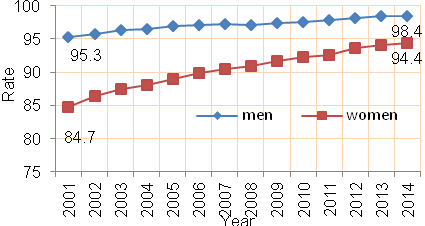
Women and social media
67.4 percent of women aged 10 years and above were using social media networks in 2014; 68.2 percent of them were using it for acquaintance, 74.4 percent for games and entertainment, 61.1 percent to make phone calls, 21.0 percent for debate and dialogue on political issues and 33.5 percent for debate and dialogue on cultural and literary topics.
A gap in the participation rate and average daily wages between men and women
The females participation rate in labour force was 19.4 percent of females in labor force in 2014 compared with 10.3 percent in 2001. The male labor force participation rate was more than three times higher (71.5 percent) than that of females.
There was a gender gap in the average daily wages: the average daily wage for females was NIS 80.9 compared to NIS 105.8 for males in 2014.
Men and women labor force participation rate aged 15 years and above during 2001-
2014
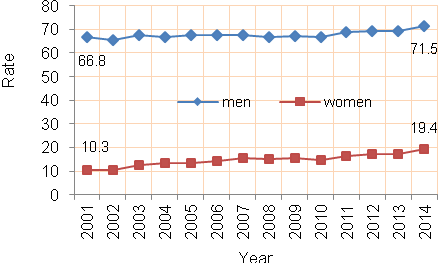
Unemployment rates among women exceed the rate among men by about 15 percent.
The unemployment rate was 38.4 percent for women against 23.9 percent for men in 2014. Needless to say that women unemployment rate was the highest among women with 13 years of schooling and above, standing at 50.6 percent.
Unemployment rate among men and women 15 years and above 2001-2014
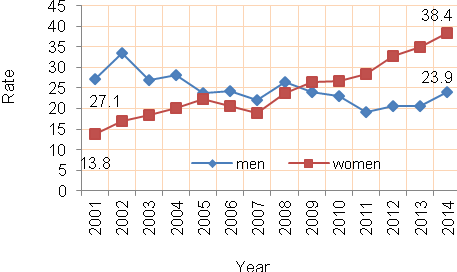
The majority of women work in the service sector (health, education and public sector)
Services and agriculture sectors comprise the main employer (job absorber) of women, accounting for 57.0 percent and 20.9 percent of the total number of employed women respectively.
Percentage distribution of employed persons 15 years and over by sex and economic activity, 2014
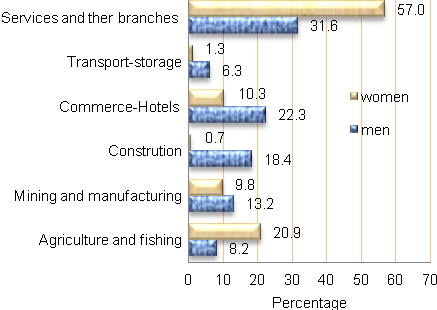
Women headed households are poorer than men headed households in the West Bank.
The proportion of poor households headed by women was higher in Gaza Strip at 29.7 percent compared to 22.5 percent in the West Bank in 2011.
Percentage of poverty by sex of household heads in 2011
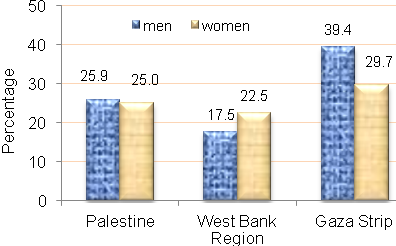
Palestinian women in public life
In 2012; 21.0 percent of the members of the local councils are females in the West Bank while 79.0 percent were males.
In 2013; 15.6 percent of females were judges whereas 84.4 percent were males and 20.0 percent of journalists were females against 80.0 percent males in Palestine. Moreover, the women ambassadors accounted only for 5.1 percent compared to 94.9 percent for males ambassadors; 41.2 percent of employees in the public sector (civil servants) were females against 58.8 percent males in Palestine.
 عربي
عربي